The first form of transport on land was, of course, WALKING!
Content
- Animals
- Carts, wagons and coaches
- The bicycle
- The steam engine and the train
- The motor car
- Common forms of transport of people and goods on land today
Then, thousands of years ago, people started to use donkeys and horses to travel and to transport things on land. Around 3,500 BC, the wheel was invented. The first wheels were simply solid discs, carved from one lump of wood. The wheel changed the way that people travelled and transported things. Before the wheel was invented, the amount of things people could transport over long distances were limited. Today wheels are used in many forms of transportation such as cars, bicycles and skate boards, but did you know that they are also found in clocks and pencil sharpeners.
The Wheel
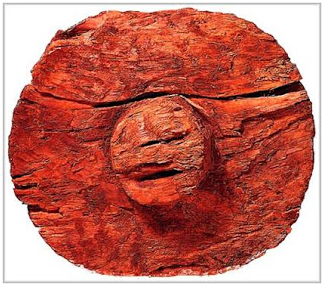 Wheel of Mesopotamia Image source
Wheel of Mesopotamia Image source
The oldest wheel that archaeologists have found came from Mesopotamia, an ancient civilisation in the Middle East. It is probably more than 5 000 years old. The wheel is one of the most important inventions ever made, and it has helped people to travel faster and further than possible on foot. It has also made it possible to transport big loads. There are many different kinds of transportation that use wheels. Some are drawn by animals, like wagons and carriages, and others are drawn by people, like the rickshaw. Cycles also have wheels, whether it is one, two three or more. Since the end of the 19th century motorcars with wheels have transformed human travel forever.
Wagons, coaches and carriages
Before people started to use wagons and carts, they would put big logs under goods they wanted to move, and roll the logs along the ground. But that was still a lot of work and probably not that easy. So they invented small vehicles with two or four wheels, which could be pulled along by people or animals.
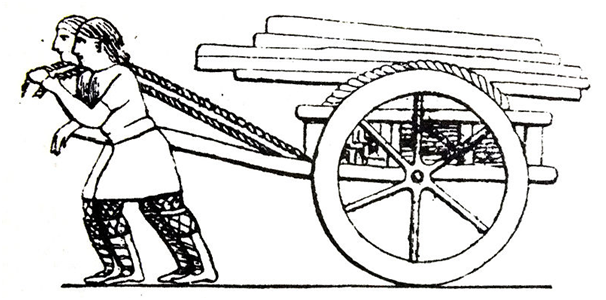 An image of a cart pulled along by people Image source
An image of a cart pulled along by people Image source
The first kinds of wheeled vehicles were carts (two wheels) and wagons (four wheels). They were drawn by animals like donkeys, horses and oxen. The first types of wagon and carts were found in Central Asia and in the Tigris-Euphrates valley in the Middle East, about 5 000 years ago. Later they were also used in Crete, Egypt, Turkey, Russia and China. Wagons and carts have been described before as 'boxes on wheels'. They could be used to carry a lot of goods over long distances, and to transport people. About 4 000 years ago people began to cover their wagons with leather or cloth. This protected the riders from the sun and rain. Animals used to draw wagons included donkeys, horses and oxen.
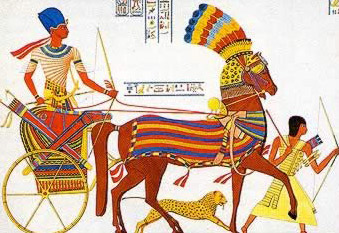 An illustration of Ramses II on a horse drawn cart Image source
An illustration of Ramses II on a horse drawn cart Image source
A carriage is a closed, horse-drawn vehicle with four wheels, used to transport people. Both the carriage and the wagon developed from the sled, which is probably the first land vehicle and was invented in prehistoric times. The sled was used in ancient Egypt to transport building materials such as heavy stones. Today sleds are known for high speed transportation through snow covered areas.
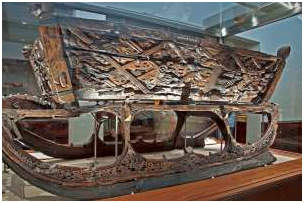 An ancient Viking sled which was found on the Osberg Viking ship. Image source
An ancient Viking sled which was found on the Osberg Viking ship. Image source
From the carriage developed the coach, a big, closed vehicle also used to transport people. A coach could carry up to eight people. Most people believe that the coach was developed in Hungary in the 15th century. The use of these vehicles spread to other parts of Europe and England in the 16th century. There have been many different kinds of carriages and coaches through the ages. Some examples are: Cabriolet, Chaise, Drag, Phaeton and Stagecoach. A stagecoach was a public transport vehicle that carried people, baggage and mail from one station to another, like a train or a bus.
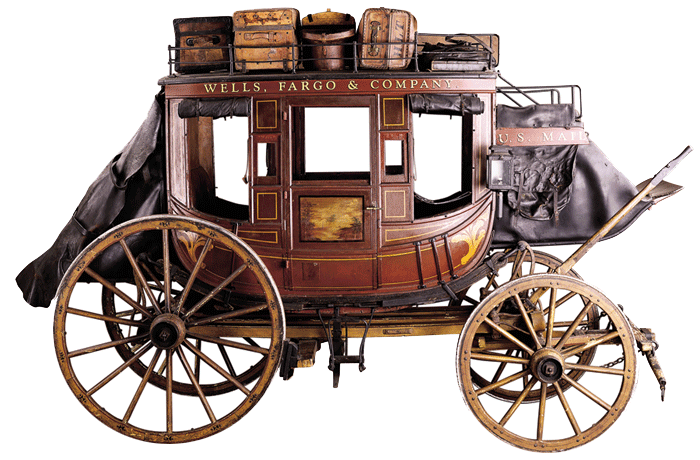 A Wells Fargo stagecoach from the mid 1800’s Image source
A Wells Fargo stagecoach from the mid 1800’s Image source
Animals as transport
A beast of burden is an animal that is used for transporting goods or for doing other heavy work. Since ancient times, people have used animals to get from one place to another, to carry and transport things or to do work like turning mills. Many different kinds of animals have been used, and are still used today. Here are some of the animals that have been used and domesticated by people to help with various tasks:
A Homing pigeon. Note the message and the thin message tube lying in front of him. Source:
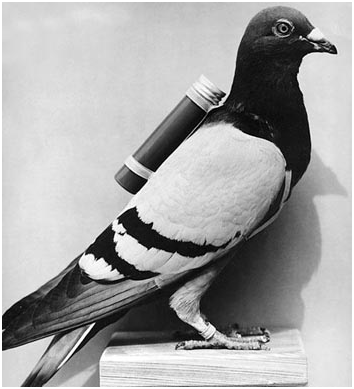 A homing pigeon with a message placed in the tube on its back. Image source
A homing pigeon with a message placed in the tube on its back. Image source
The Pigeon
The Homing Pigeon is a bird that is able to find its way home from very far off. This made it possible for people to send messages to others. The message would be written on a very thin piece of paper and put into a small tube. It was then tied to the pigeon's leg. The pigeon would then be thrown in the air to fly back home to deliver the message. It is possible that pigeons have been used to deliver messages as long ago as 1150, in Baghdad.
Homing pigeons played a very important role during the First World War. It is estimated that over 100 000 pigeons were used to transport messages during WWI. One of these birds was called 'Cher Ami' which means 'Dear Friend'. He received a special award from the French army for his services during the war. He delivered more than 10 important messages, and was even shot once.
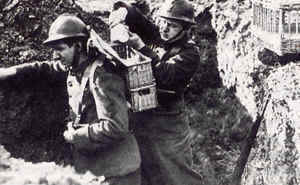 A French soldier carrying homing pigeons in the basket on his back during WWI. Image source
A French soldier carrying homing pigeons in the basket on his back during WWI. Image source
Donkeys and mules
Donkeys and mules Donkeys are domestic animals that were originally wild donkeys from Africa. Donkeys have been used since earliest times in Europe and Asia to carry riders, their loads, to pull carts and to do heavy work. Today they are still being used in many countries all over the world. In some countries they are not used as beasts of burden anymore, but are kept as pets because they are clever, playful and friendly. In Africa, donkeys were used to carry goods through the desert. This was very important for trade across the Saharan desert. But donkeys cannot survive long without food and water, and from about the 3rd century they were replaced by camels. In South Africa, donkey carts can still be seen in many rural areas. A mule is a cross between a female horse and a male donkey. People have used mules since ancient times. The ancient Greeks and Romans used them to pull carts and to carry loads. In the 20th century, they were used for military transport. They have become less common since the invention of cars and tractors, but they are still useful in areas that are not accessible to cars.
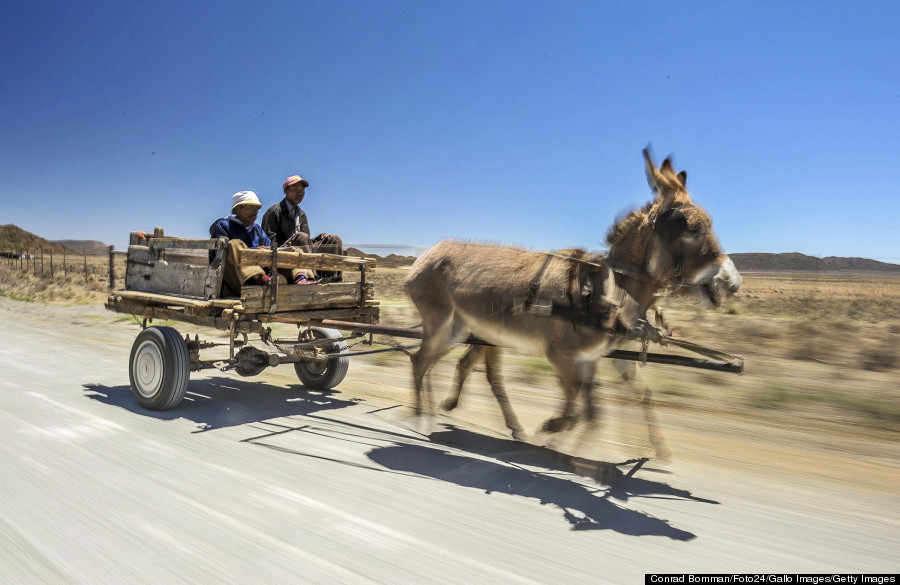 South Africans using a donkey to travel to town. Image source
South Africans using a donkey to travel to town. Image source
Horses
The horse has been one of the most important beasts of burden for hundreds of years. They have been used for travel, to draw carts, carriages, trams and other wheeled vehicles, to plough fields and to carry loads. People use a range of different tools to ride on a horse. These include the saddle, stirrups, and reins. Horses were even used to draw boats between about 1630 to about 1850. Horse-drawn boats were also called tow-boats. They would sail on a canal and were drawn by horses walking along special paths along the canal. These paths were called the 'tow-paths'. Horse-drawn boats were used for goods as well as for public transport.
 A painting of horses used for transportation during the 18th dynasty in Ancient Egypt. Image source
A painting of horses used for transportation during the 18th dynasty in Ancient Egypt. Image source
Oxen
An ox is a bull that has been castrated. The term is also used to refer to any cattle used as beasts of burden. Oxen have many uses. They can be used for ploughing, transport, pulling heavy things, grain-grinding (like donkeys) and to draw wagons. They are usually used in pairs. A yoke is put on their necks, so that the weight of the load being pulled is distributed equally across their shoulders. Oxen are very strong. Although they are not as fast as horses, they do not get injured as easily. In South Africa, oxen have been used for hundreds of years, for example to plough the land. During the Great Trek, the Boer families who left the Cape to go and live in the interior used ox-wagons to travel. These were wagons covered with a sail and pulled by many oxen. In the wagons the Boers had all their furniture and other possessions. With their ox-wagons, they travelled very far – as far as what is today the Limpopo Province, Mpumalanga and even Maputo. They oxen had to trek over the Drakensberg and other mountain ranges, through rivers and veld.
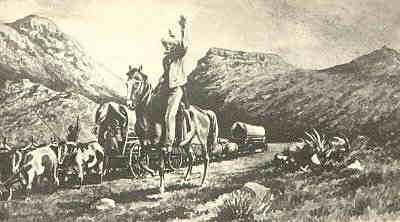 During the Great Trek, the Voortrekkers had to move over mountains and rivers with their ox. Image source
During the Great Trek, the Voortrekkers had to move over mountains and rivers with their ox. Image source
Camels
 A caravan of camels travelling through the Sahara desert. Image source
A caravan of camels travelling through the Sahara desert. Image source
Camels were first domesticated in Arabia thousands of years ago. Because they can go for a long time without food or water, are strong and can walk easily through sand, they were very useful for transport and travel in the Arabian desert. In the 3rd and 4th centuries, camels spread to the African Sahara. They replaced donkeys, horses and oxen to transport people and goods through the desert. Now, the people from North Africa could trade more easily and regularly with the people south of the Sahara.
Elephants
Elephants are not only found in Africa. The cousin of the African elephant, the Asian or Indian elephant, is slightly smaller and easier to tame. In Asia, elephants have been tamed and used for travel and transport since ancient times. They have also been used in wars. Other animals that have been used for travel and transport through the ages are dogs, llamas, reindeer and water buffalo.
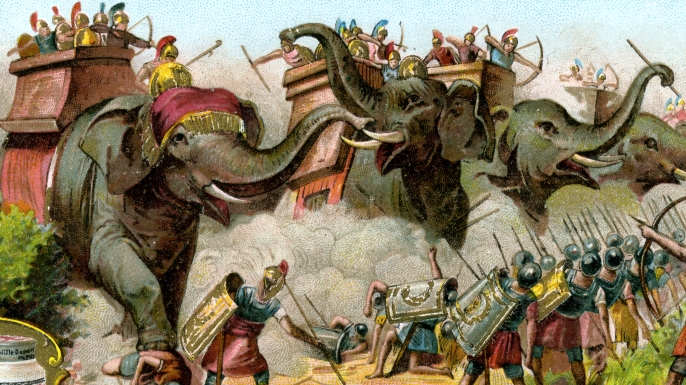 An illustration of elephants used in war by Greek general Pyrrhus in 279 BC. Image source
An illustration of elephants used in war by Greek general Pyrrhus in 279 BC. Image source
Bicycles and Motorbikes
The first bicycle was developed between 1790 and 1817. It was a bit different from today's cycles. The pedals are connected to the back wheel with a chain, and as the rider pedals, the wheels turn. The first bicycle did not have pedals, and the rider had to steer it by pushing his or her feet along the ground. These vehicles were not called bicycles in those days. They were given various other names as they developed.
An animation illustrating the development of the bicycle
During the 19th century the cycle developed quite a bit. First, the German, Karl von Drais developed a cycle whose front wheel could be steered. In other words, it could turn in different directions so that the rider could go in the direction he wanted simply by turning the handles bars. It was called the 'Draisienne' or 'Dandy Horse'. Then Scotsman Kirkpatrick MacMillan made the first cycle with pedals in 1839. In the 1860s the 'velocipede' or ‘bone shaker’was invented in France. This vehicle was powered by wooden pedals which were attached to the front wheeland a framework made from wrought iron. The bigger the wheel was, the faster the velocipede could go. This led to cycles with very large front wheels and smaller back wheels. They were called Penny Farthings in England, because the front wheel represented an English coin called a penny, and the back wheel a much smaller coin called a farthing. But these cycles were very dangerous because the rider would sit very high up, on top of the front wheel. Because the front wheel was so big, they could also go very fast. So when the rider hit a bad spot in the road, he would fall over the front wheel and get seriously injured. Some people were even killed in this way.
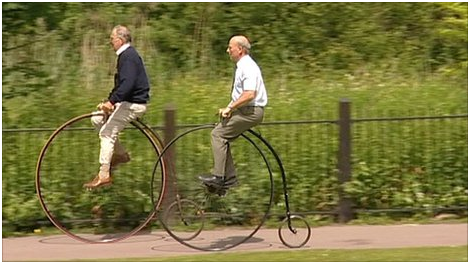 Two men riding penny farthings in the Knutsford Great Race in Britain. Image source
Two men riding penny farthings in the Knutsford Great Race in Britain. Image source
Eventually, in 1885, the bicycle as we know it today was invented in England in 1885. Known as the first ‘safety’ bicycle, it was invented by John Kemp Starley. He made history when he produced ‘The Rover’ safety bicycle. It became popular because it had two wheels that were the same size and was much safer than the Penny farthing. Further developments were made in the following 20 or so years, for example pneumatic tyres, gears and engines were added.Bicycles then became motorized in later years and when the petrol engine was invented, motorcycles were invented.
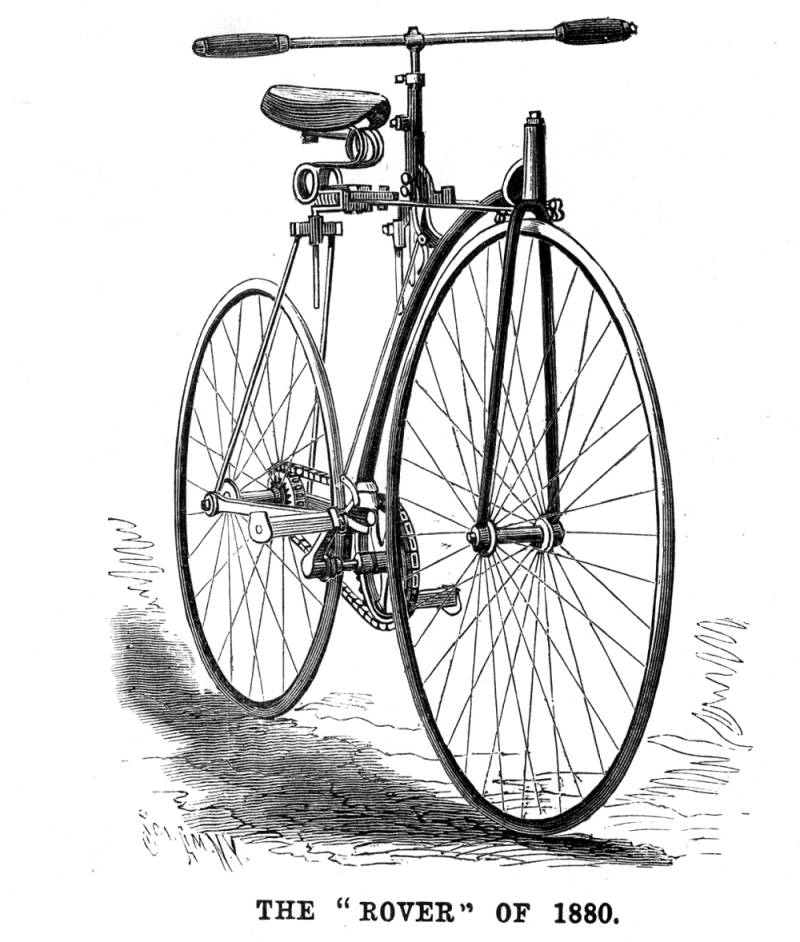 The Rover Safety Bicycle developed by J.K. Starley. Image source
The Rover Safety Bicycle developed by J.K. Starley. Image source
Gottlieb Daimler developed the motorcycle in 1885. His was not the first attempt to motorise bicycles. Earlier attempts by inventors such as Sylvester Howard Roper included experiments where steam engines were attached to bicycles. However, theydid not work well, and it was only when the petrol engine was invented that motorcycles really became practical. Daimler’s motorcycle consisted of a single-cylinder internal combustion engine mounted on a wooden frame with iron-banded wooden wheel. It was known as the “boneshaker” for its jarring ride. In 1899 American entrepreneur and bicycle manufacturer Charles H. Metz created America’s first production motorcycle.By 1903 the iconic motorcycle brand, Harley-Davidson, is launched and starts producing bikes with their signature V-Twin engine.
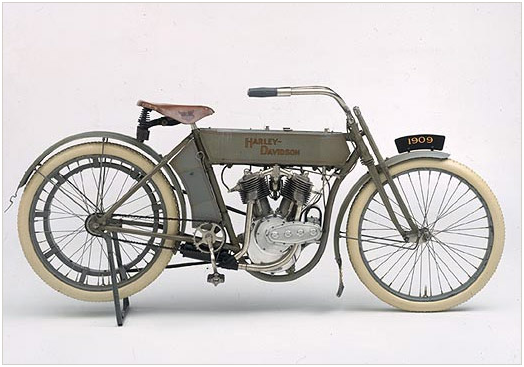 A 1909 Harley Davidson. Image source
A 1909 Harley Davidson. Image source
Today, motorised bicycles include the motorcycle (also called the motorbike), mopeds and scooters.There are also many variations on the bicycle. In circuses, you might see clowns riding on one big wheel with pedals. That is called a monocycle. A cycle with three wheels is called a tricycle. 'Mono' means one, 'bi' means two and 'tri' means three. You also get cycles that have saddles and pedals for two riders. They are called tandems.Two other types of wheeled vehicles are skateboards and roller-skates.
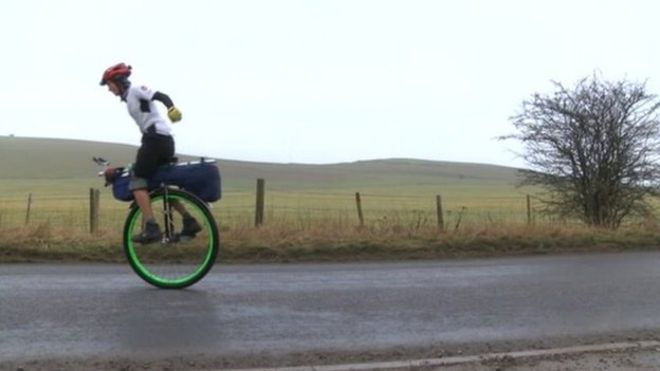 Ed Prat, a 19 year old who is currently attempting to be the first person to unicycle around the world. Image source
Ed Prat, a 19 year old who is currently attempting to be the first person to unicycle around the world. Image source
There are also other ways to travel with wheels. One is by rickshaw, a two-wheeled cart in which one or two or so people can ride. It is pulled by another person. The rickshaw was invented in Japan and also became popular in China and India. In South Africa, people can take rickshaw rides in Durban for fun.
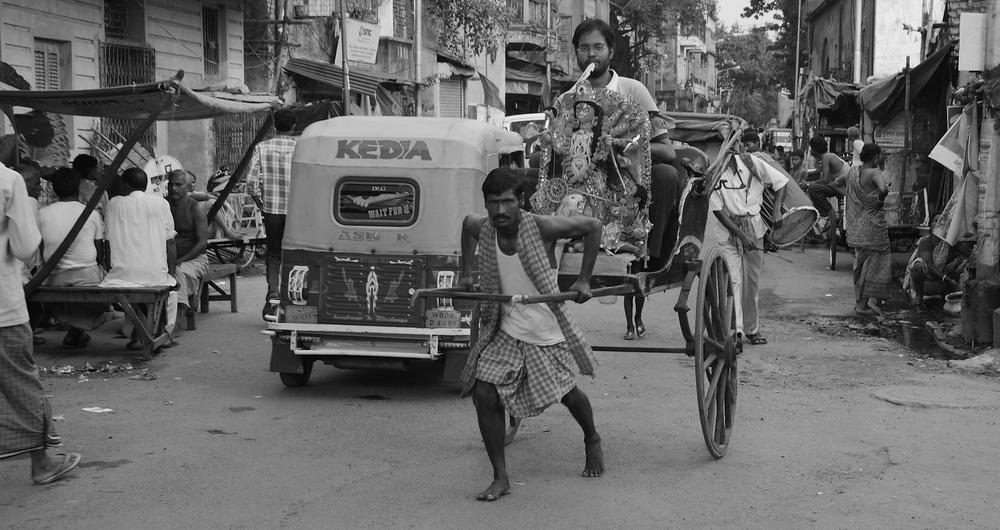 A hand-pulled rickshaws, a mode of transport in the eastern city of Kolkata, India. Image source
A hand-pulled rickshaws, a mode of transport in the eastern city of Kolkata, India. Image source
The Steam engines, trains and Trams
The train was first invented in the beginning of the 19th century. But the idea of a vehicle running along a fixed track is actually much, much older. At least 2000 years ago, the Greeks and Romans had horse-drawn wagons that ran along stone tracks. For many years these vehicles disappeared, but then the Europeans started to use them again around 1550, using wooden tracks. More than 200 years later, they began to make the tracks from iron. This would develop into the world's first public railway, but not as it is known today. It was still drawn by a horse. It was called a tramway, and the horse-drawn cars were known as trams.
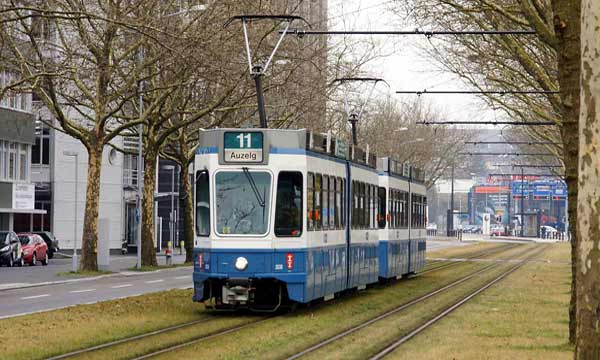 A tram in Zirich Switzerland. Image source
A tram in Zirich Switzerland. Image source
James Watt
The first practical steam engine capable to pump water was built by Thomas Newcomene in 1712. Known as the Newcomene steam engine, it was improved by Scottish inventor James Watt. The improvements made by Watt were instrumental to the changes brought by the Industrial Revolution in Great Britain and the rest of the world. While working at the University of Glasgow, Watt became interested in the technology of steam engines. In the mid 1760’s, Watt was tasked with repairing a model Newcomen engine. Through repairing the engine he realised that it was not very effective and that he could actually improve on the design. He began creating a separate condensing chamber for the steam engine which prevented enormous losses of steam.Steam engines are external combustion engines, where the working fluid is separate from the combustion products. A steam engine uses steam as its working fluid. He eventually partnered with Matthew Boulton who owned an engineering company in in 1775. Together they formed Boulton and Watt, which became the most important engineering company in the country. Their inventions drastically improved the power, efficiency, and cost-effectiveness of steam engines. Watt went on to develop the concept of horsepower and after his death in 1819, the unit of measurement of electrical and mechanical power called the watt, was named in his honour.
 James Watt Image source
James Watt Image source
The train developed out of the steam engine that James Watt developed in the 1760s. Trains were the product of the Industrial Revolution and were aided by the growth of coal mining. Trains transported coal and raw materials and they drastically cut the cost of distribution. In 1804 a steam locomotive ran on tracks for the first time, and these were soon bettered by George Stephenson. The first major railway was built in 1830, between Liverpool and Manchester in England. By 1850, approximately 2 million tons of iron had been used to make railway tracks and locomotives known as “iron horses” were now reaching speeds of up to 65 kilometres per hour.Railways soon spread throughout the world. Before the invention of cars and planes, trains were the most important way to transport goods and people over long distances on land.
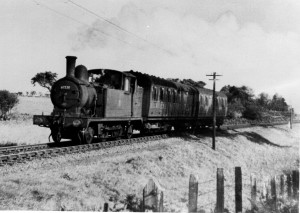 Steam train Image source
Steam train Image source
Then the steam locomotive was invented. It developed out of the steam engine that James Watt developed in the 1760s. In 1804 a steam locomotive ran on tracks for the first time, and these were soon bettered by George Stephenson. The first major railway was built in 1830, between Liverpool and Manchester in England. Railways soon spread throughout the world. Before the invention of cars and planes, trains were the most important way to transport goods and people over long distances on land.
Since the invention of the steam train, many further developments have been made. Nowadays, trains work with electricity and not steam. Diesel engines have also been used. In some large cities like London, Paris and New York underground trains are a very popular form of public transport. There are also some very fast trains, like the TGV in France (TGV stands for 'train of great speed').
A video explaining the history of the steam engine
In the meantime, the horse-drawn cars known as trams did not die out with the arrival of the train. It was still a popular form of public transport in the middle of the 20th century, also in South Africa. Like trains, trams were later made to run on electricity instead of being pulled by horses. An electric rail would run along the track, above the train, and the train would be connected to the wire as far as it went. Trams have also been known by other names, like streetcars and trolleys, and are still being used in some parts of the world.
Motorcars
The problem with animal-drawn vehicles is that if something goes wrong with the animals you are stranded. Animals are also expensive, because they need food, medicine and a lot of care. So the ideal would be to develop a vehicle that could be powered by something other than animals, like an engine.
A video showing the history of the modern car
The first vehicles that propelled themselves were already invented in the 18th century. They were powered by steam. The first car was invented in 1769, by French inventor Nicolas-Joseph Cugnot. His car could travel at about 4 km/h and was called the 'Steam Wagon'. It had three wheels, two in the back and one in the front. The steam boiler was in front. But in 1771, the vehicle crashed into a brick wall. As far as we know, this was the first car accident, and it was one of the reasons why the experiment with such vehicles was stopped.
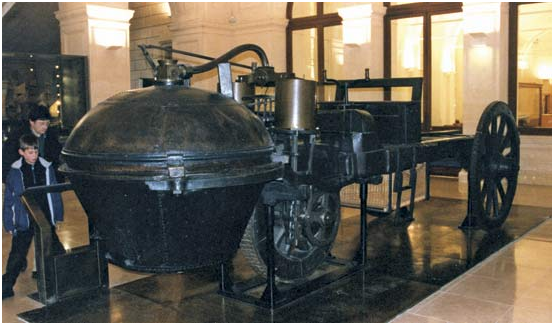 A replica of the first car built by Nicolas-Joseph Cugnot. Image source
A replica of the first car built by Nicolas-Joseph Cugnot. Image source
These cars were never really popular in France. But in Britain a similar vehicle was developed in 1801 and it became quite popular. They were developed further, with hand brakes and speed control. But these cars were heavy and fast, and many thought they were dangerous. A law was passed that in order to drive a car like that on a public road in Britain, there had to be a person walking in front of the car, waving a red flag and blowing a horn. Naturally, people did not like this law and cars became less popular. For the rest of the 19th century, inventors occupied themselves with developing steam trains, which had become very important in the Industrial Revolution. It was only much later in that century that cars would get much attention again.
The invention of the car and the industrial revolution
By the end of the 19th century there were cars powered by steam, by electricity and by petroleum (petrol). The makers of these different types of cars competed with each other for many years. The electrical cars became very popular in the early 1800’s but they could not travel faster than 32 km/h and the battery had to be recharged every 80 km. The first petrol cars were invented in the 1980’s. In the end, the petrol car won, and it is still the car used today. These cars had internal combustion engines which meant the engine could burn the petrol inside itself to produce energy to make the car move. This car was able to travel 10 km in two hours.
The modern car was invented in 1896. The type of engine we use in our cars today was built in Germany by Karl Benz and Gottlieb Daimler and the general design of cars we use today was developed in France. Daimler developed a motorized carriage which was the world’s first four-wheeled automobile and featured the first high-speech gasoline engine. In 1885 Benz invented a three wheeled vehicle that was powered by an internal-combustion engine. He went on to build his first four-wheeled car in 1891 and Benz & Company, the company started by Benz, became the world's largest manufacturer of automobiles by 1900.
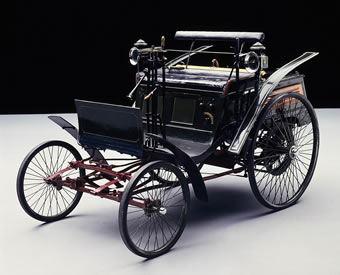 The Benz Patent Motor Car Velocipede Of 1894. Image source
The Benz Patent Motor Car Velocipede Of 1894. Image source
At the time of all these developments in Europe, cars were being made in the United States of America (USA) as well. In the USA, cars are often called automobiles. The first one was demonstrated in 1804 by Oliver Evans. This car could travel on land with wheels like a normal car, but it could also paddle on water. Just like Cugnot's car, it was powered by steam. The next step in the development of the car came at the end of the century.
Henry Ford and the Model T
Henry Ford, a pioneer American automaker, wanted to make a car that many people in all walks of life could afford. The only way to do this was to improve the assembly line methods, which he did. Ford broke the Model T’s assembly into 84 steps, and trained each of his workers to do just one. He achieved his goal with his car called Model T in 1908 which he sold for 850 dollars. In 1916 he was able to sell the same car from 400 dollars as he was able to cut the assembly line time form 12 and a half hours to 1and a half hours. Ford sold over 15 million cars from 1908 to 1927.
The first cars were all made individually. The parts were made separately and then put together by hand. This took much too long. In 1913 the American car maker Henry Ford began to use an assembly line to make his cars. An assembly line is a way of producing many things in a short time. It is a line of machines and people. Each of these are responsible for a certain step in putting something, like a car, together. For example, at one point a machine will put in the engine. The car will then move along the line to the next point, where something else will be put into place. By the time it reaches the end of the long line, the car is complete. This is called mass production, because products can be made in large quantities. It made cars much quicker and cheaper to make and buy. Henry Ford was not really the first car maker to use this method, but he developed it further and made it common practice.
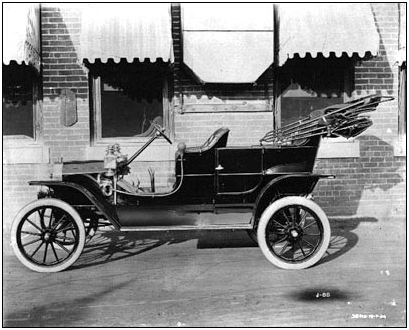 The Ford Model T in 1908. Image source
The Ford Model T in 1908. Image source
Cars have developed a lot since then. Some of the first further developments were things like the electric ignition and brakes for all four wheels. Today, cars can be very advanced. Where the first car could travel at about 5 km/h, cars can now drive faster than 200 km/h. The first recorded long drive in a car in Britain was in 1895, and it was just over 90 km long. Today, cars travel for thousands of kilometres at a time. Some of the more expensive cars include CD players, computer screens, televisions, even fridges. But no matter how luxurious or simple, cars have become one of the most important ways to travel, especially in the city. In South Africa a lot of people have their own cars, and others travel by taxi or bus, which are really large cars.
For more information on the first motorcars invented visit: The First Car - A History of the Automobile: www.en.wikipedia.org
Further reading: An early motor journey: Johannesburg to Durban 1912
In the Rand Daily Mail for 27 May 1912 may be found a full account of a paper read by Mr. Ed. H. Waugh, Municipal Building Surveyor of Johannesburg, before the Transvaal Automobile Club, on his motor trip to Durban.
Mr. Waugh and his bride, a recent arrival from England, set off on their journey on the afternoon of their marriage and spent the first night camping alongside the Zuikerboschrand Spruit ten miles beyond Heidelberg. An unexpected visitor whose "rough hairy visage" peered through the tent flap proved merely to be "a resident Boer full of curiosity". Waugh's car, which has been traced from early Johannesburg motor licensing records, was originally registered as Johannesburg No. 97 and later as TJ 68. It was a two speed, cylinder Buick, appropriately painted white. Apart from the tent it was loaded with ropes, a small grapnel, wheel chains, tins of petrol and oil, a canvas cover, tin wash basin, picnic basket, spare tubes and a good selection of tools. Petrol, the wooden cases each containing two four gallon tins that preceded petrol pumps, was collected en route from points to which it had been railed, namely Grootvlei Colliery, Harrismith and Ladysmith. Further down in Natal it would be available at trading stores. Crossing the Vaal at "de Villiersdorp" by the pont, since the drift proved too deep at three feet, they passed through Frankfort, spent a windy night in the tent and reached Harrismith and the Royal Hotel at dusk on the third day. An attempt to travel via Witzie's Hoek Pass was abandoned when Mrs. Waugh became alarmed at the menacing attitude of black passersby, so it was back to Harrismith for the alternative van Reenen's Pass route. The railway had caused the once-vital wagon pass to fall into disuse and it was not until the Buick had taken a severe buffeting, and two nights had been spent with an intervening distance of fifteen miles, that Ladysmith and its welcome Royal Hotel was reached.
The main Natal high road, stretching 150 miles to Durban, was described as “magnificent, well-built, drained and bridged” (one wonders how it would strike today’s motorists). Mention was made, however of the great hill after Estcourt, still formidable today, which was successfully climbed on the lower of only two gears at a steady two miles and hour! Thereafter the travellers found the going easy and the weather and scenery delightful. With overnight stops at howick and Hillcrest they drove proudly down West Street after ten days actual motoring.
In Mr. Waugh’s words – “Thus we finished a trip which with all its hard work was most enjoyable. The car behaved splendidly throughout and there was no stoppage from any mechanical fault or fault of manufacture. The actual distance from Johannesburg to Durban was 412 miles and the total mileage actually covered was 462, being measured by a tested Stweart speedometer.”
The American “Stewart” speedometer was a popular accessory at the time when speedometers were seldom supplied as standard equipment. The agents were 'The Johannesburg Motor Mart'.
Johnston, R.H. (1979). “An early motor journey: Johannesburg to Durban in 1912”, Africana Notes and News, 23(7), pp.285-6.
Common forms of transport of people and goods on land today
Today we use cars, trucks, trains, buses, motorbikes and bicycles to transport people and goods.
There are now so many cars that many people are worried about congestion and the effect this is having on our world and our health.
Many people think we should walk, cycle or use Public Transport in the future instead of travelling by car. Public Transport such as buses, trains, metro and trams are a much more efficient use of fuel because they can carry lots of passengers at once.
Transport has changed and it will change some more in the future. Perhaps we will all get to travel into space! But walking and cycling might be the most popular ways to travel in the future as we all try to stay fit and healthy and look after our planet!